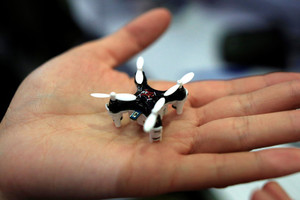
Scientists have started shrinking sensors from millimeters or microns in size to the nanometer scale, small enough to circulate within living bodies and to mix directly into construction materials. This is a crucial first step toward an Internet of Nano Things (IoNT).
The Internet of Things (IoT), built from inexpensive microsensors and microprocessors paired with tiny power supplies and wireless antennas, is rapidly expanding the online universe from computers and mobile gadgets to ordinary pieces of the physical world: thermostats, cars, door locks, even pet trackers. New IoT devices are announced almost daily, and analysts expected to up to 30 billion of them to be online by 2020.
The explosion of connected items, especially those monitored and controlled by artificial intelligence systems, can endow ordinary things with amazing capabilities—a house that unlocks the front door when it recognizes its owner arriving home from work, for example, or an implanted heart monitor that calls the doctor if the organ shows signs of failing. But the real Big Bang in the online universe may lie just ahead.
Scientists have started shrinking sensors from millimeters or microns in size to the nanometer scale, small enough to circulate within living bodies and to mix directly into construction materials. This is a crucial first step toward an Internet of Nano Things (IoNT) that could take medicine, energy efficiency, and many other sectors to a whole new dimension.
Some of the most advanced nanosensors to date have been crafted by using the tools of synthetic biology to modify single-celled organisms, such as bacteria. The goal here is to fashion simple biocomputers that use DNA and proteins to recognize specific chemical targets, store a few bits of information, and then report their status by changing color or emitting some other easily detectable signal. Synlogic, a start-up in Cambridge, Mass., is working to commercialize computationally enabled strains of probiotic bacteria to treat rare metabolic disorders. Beyond medicine, such cellular nanosensors could find many uses in agriculture and drug manufacturing.
Many nanosensors have also been made from non-biological materials, such as carbon nanotubes, that can both sense and signal, acting as wireless nanoantennas. Because they are so small, nanosensors can collect information from millions of different points. External devices can then integrate the data to generate incredibly detailed maps showing the slightest changes in light, vibration, electrical currents, magnetic fields, chemical concentrations and other environmental conditions.
The transition from smart nanosensors to the IoNT seems inevitable, but big challenges will have to be met. One technical hurdle is to integrate all the components needed for a self-powered nanodevice to detect a change and transmit a signal to the web. Other obstacles include thorny issues of privacy and safety. Any nanodevices introduced into the body, deliberately or inadvertently, could be toxic or provoke immune reactions. The technology could also enable unwelcome surveillance. Initial applications might be able to avoid the most vexing issues by embedding nanosensors in simpler, less risky organisms such as plants and non-infectious microorganisms used in industrial processing.
When it arrives, the IoNT could provide much more detailed, inexpensive, and up-to-date pictures of our cities, homes, factories—even our bodies. Today traffic lights, wearables or surveillance cameras are getting connected to the Internet. Next up: billions of nanosensors harvesting huge amounts of real-time information and beaming it up to the cloud.
(Maybe interesting: Internet of Nano Things Market to 2025 - Global Analysis and Forecasts by Component, Connectivity Technology and Application)
Quelle: World Economic Forum
